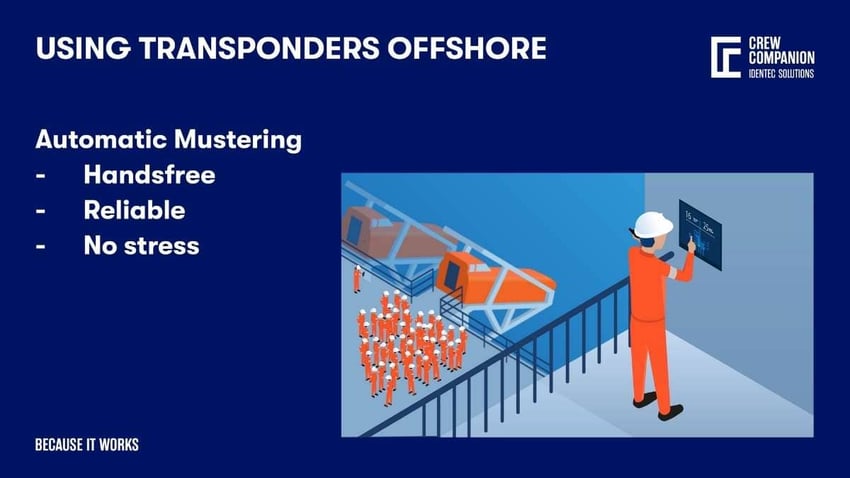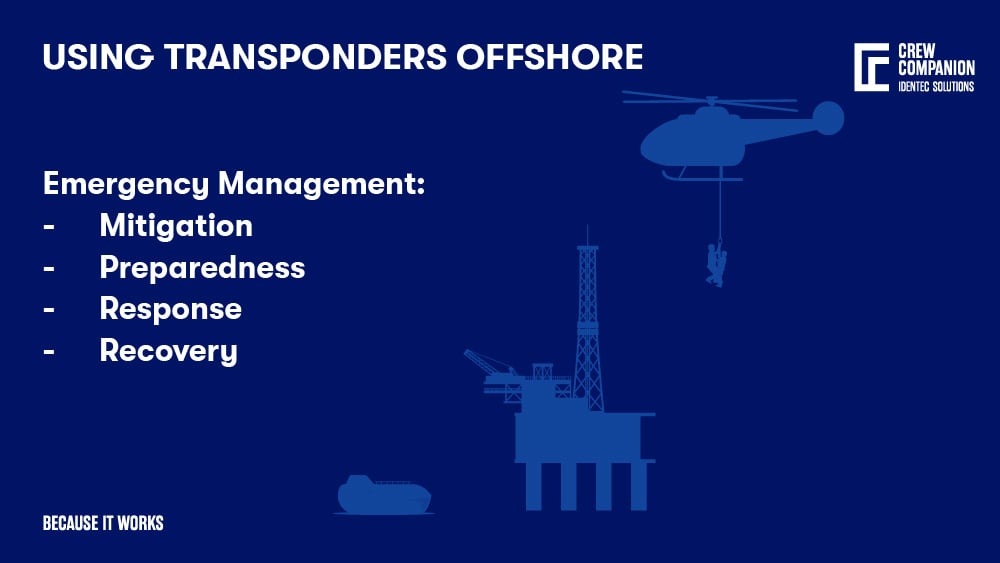Emergency Mustering: How to use Transponders to their full potential
| Written by Mark Buzinkay
Everyone must be accounted for when an emergency occurs on an offshore installation as quickly as possible. This is why transponders are such an essential tool for emergency mustering.
In this extended article/whitepaper, we will discuss the benefits of using transponders for emergency mustering and how they can help save lives in the event of an emergency.

No video selected
Select a video type in the sidebar.
Table of contents:
- What Are Transponders, And What Do They Do
- Emergency Management
- How Are Transponders Used During Emergency Mustering
- Why Is It Essential To Have Transponders In Place On Offshore Installations
- The Benefits Of Using Transponders For Emergency Mustering On Offshore Installations
- Make Sure Your Emergency Plan Is Effective
- Takeaway
What are transponders, and what do they do
Transponders (sometimes called tags) are small electronic devices that emit signals in response to incoming signals. This signal can be used to track the device's movement or location. Transponders are often used in emergencies to help locate and muster personnel. They can be attached to clothing, equipment, or vehicles and help responders quickly identify and find individuals in a large area.
Transponders can be a critical tool in emergencies, particularly on offshore installations where personnel may be scattered across an obscure area. Using automatic reading devices, responders can quickly locate individuals and muster them to a safe zone. In some cases, transponders may also track the movements of vehicles (like rafts) or other assets.
While transponders can be a helpful tool in emergencies, it is vital to ensure that they are correctly configured and maintained. Not properly working transponders can create false signals that may lead responders astray. Additionally, if transponders are not correctly configured, they may not emit a signal, rendering them useless in an emergency.

Emergency management
In 2020, the Bureau of Safety and Environmental Enforcement (BSEE) registered 614 incidents on offshore installations that led to 81 musters (source). In 2019 (87) and 2018 (82), the industry experienced a similar number of musters. In order to prevent injuries, fatalities and loss of wealth, offshore installations put emergency management in place.
Emergency management is a coordinated effort to reduce the impact of a disaster. It includes activities such as preparedness, response, recovery, and mitigation. Emergency teams should coordinate emergency management efforts among all relevant agencies and organisations. Disaster management aims to reduce the overall risk to the crew and the community posed by a disaster. Some typical disaster management activities include: creating emergency plans, identifying essential personnel and critical resources, conducting training and drills, establishing lines of communication, stockpiling supplies, evacuating people to safe areas, providing medical treatment, setting up shelters, restoring utilities, clearing debris, rebuilding infrastructure, and providing economic assistance.
Mitigation
Organisations should clearly understand their risks and vulnerabilities to develop an effective mitigation strategy. The goal of mitigation is to reduce the probability of occurrence, the severity of impact, or both. Typically, mitigation strategies include land-use planning (e.g., zoning), engineering solutions (e.g., flood levees), building code requirements (e.g., earthquake-resistant construction), public awareness and education (e.g., fire safety), and disaster insurance programs.
Preparedness
Preparedness activities should be tailored to each organisation's specific risks and vulnerabilities. Some standard preparedness measures include: developing emergency plans and procedures, identifying essential personnel and key resources, conducting training and drills, establishing lines of communication, and stockpiling supplies. Having a POB list is vital to emergency preparedness on offshore installations. The muster list will define the essential duties like closing the watertight doors, skylights, portholes and other openings; carriage of equipment and readying the survival craft and other life-saving appliances; muster of the crew, etc.
Response
Response is the immediate reaction to an event or incident that requires a coordinated effort to protect life, property, and the environment. Response activities are typically divided into three phases: initial response, recovery operations, and final restoration. Initial response activities focus on stabilising the situation and preventing further loss or damage.
Recovery
Recovery is the long-term process of rebuilding and recovering from the effects of a disaster. Recovery operations cluster into three phases: immediate recovery, short-term recovery, and long-term recovery. Primary recovery activities focus on stabilising the situation and preventing further loss or damage. Short-term recovery efforts are primarily concerned with actions that involve rebuilding destroyed property, re-employment, the repair of other essential infrastructure, as well as the re-opening of essential services. Finally, long-term recovery activities deal with returning the affected area to its pre-disaster condition.
How are transponders used during emergency mustering
During the response stage of an emergency on an offshore installation, it is vital to quickly and efficiently muster the personnel on board. Transponders can help with this process by locating crews rapidly and efficiently. When activated, transponders worn or carried by personnel send a signal that receivers on board the installation can detect. This allows for a much faster and more effective response in an emergency (read more about worker safety monitoring).
The Personnel on Board (POB) list is the base for the mustering list. The POB List, a document containing the overall count of all persons at the workplace on a given day, including the name, position and cabin number, must be kept up-to-date at all times. Otherwise, providing a correct mustering list in an emergency will be impossible (see also: Providing an accurate mustering report).
There are several different types of transponders available, and the most suitable type will depend on the specific requirements of the offshore installation. For example, some transponders are designed to be used in conjunction with GPS systems, while others may use radio frequency or other forms of technology. Therefore, selecting a transponder compatible with the systems and equipment already in place for offshore installation is essential. In addition, it must be suitable for a given environment.
Why is it essential to have transponders in place on offshore installations
Transponders can be extremely effective for emergency mustering and help save lives. Therefore, offshore installations should consider using transponders as part of their emergency response plan.
When an emergency occurs on an offshore installation, the first thing needed is an accurate headcount of everyone on site. This is where transponders come in, as they can be used to quickly and easily locate people in an emergency. Personnel wear tags, and readers are placed strategically around an installation, such as exits and firefighting equipment.
Designated muster areas equipped with readers are important to ensure that everyone is quickly and safely accounted for. A muster plan assigns personnel to specific locations where transponders automatically muster to the system. Transponders also help track personnel movements and ensure everyone has evacuated the area safely. Otherwise, they will transmit the last recorded position of the tag holder (more about mustering solutions: the analogue T-card system).

The benefits of using transponders for emergency mustering on offshore installations
As mentioned above, transponders offer many benefits for emergency mustering on offshore installations. They provide an efficient and accurate way to track personnel's location in an emergency and broadcast important safety information. In addition, transponders can be used to monitor the status of equipment and systems in the event of an emergency and can help facilitate the coordination of rescue efforts. Overall, transponders offer a versatile and powerful tool for emergency response on offshore installations.
Managers can more effectively coordinate response and recovery efforts by having an up-to-date and accurate record of who is on-site and where they are located. Electronic mustering also allows for better tracking of employee training and certifications, which can be critical in an emergency. With so many benefits, there's no reason not to implement electronic mustering at your facility (see also: electronic T-card systems).
Make sure your emergency plan is effective
When planning for emergency mustering on offshore installations, it is crucial to ensure that your plan is effective. There are a few things you can do to make sure your emergency mustering works well:
- Make sure all personnel know the emergency procedures and where to find the assigned mustering area.
- Make sure all personnel know to wear their tag at all times.
- Test the transponders regularly to ensure they are working correctly.
- Keep the transponders updated with the latest software and firmware.
- Make sure the transponders are correctly maintained and serviced.
By following these tips, you can ensure your transponder system is working effectively and helps keep your personnel safe in an emergency.
Learn also more about walk-to-work.
TAKEAWAY
Transponders are electronic devices that store and transmit information. In emergencies on offshore installations, they are mainly used for mustering by automatically reading the location of people and equipment, avoiding human errors under situational stress. Furthermore, as transponders are rugged and durable, they work in harsh conditions reliably during emergencies.
Please get in touch with us if you want to learn more about transponders and how they can be used on offshore installations. We would be happy to discuss your specific requirements and provide further information.
Enjoy our full collection of articles and whitepapers about Personnel On Board (POB)
Sources:
(1) Netscher Nick, Thompson Jaime (2019) Managing escape, evacuation and rescue (EER) risk on aging offshore facilities. The APPEA Journal 59, 260-267. https://doi.org/10.1071/AJ18133
Note: This article was updated on the 18th of August 2025. This article was partly created with the assistance of artificial intelligence to support drafting. The head image was generated by AI.

Author
Mark Buzinkay, Head of Marketing
Mark Buzinkay holds a PhD in Virtual Anthropology, a Master in Business Administration (Telecommunications Mgmt), a Master of Science in Information Management and a Master of Arts in History, Sociology and Philosophy. Mark spent most of his professional career developing and creating business ideas - from a marketing, organisational and process point of view. He is fascinated by the digital transformation of industries, especially manufacturing and logistics. Mark writes mainly about Industry 4.0, maritime logistics, process and change management, innovations onshore and offshore, and the digital transformation in general.





